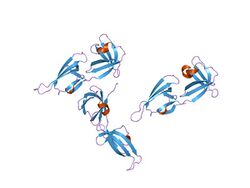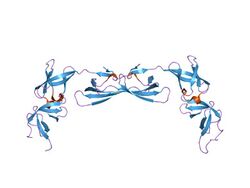Biology:Elongation factor P
| Elongation factor P (EF-P) KOW-like domain | |||||||||
|---|---|---|---|---|---|---|---|---|---|
 crystal structure of translation initiation factor 5a from pyrococcus horikoshii | |||||||||
| Identifiers | |||||||||
| Symbol | EFP_N | ||||||||
| Pfam | PF08207 | ||||||||
| Pfam clan | CL0107 | ||||||||
| InterPro | IPR013185 | ||||||||
| PROSITE | PDOC00981 | ||||||||
| |||||||||
| Elongation factor P (EF-P) OB domain | |||||||||
|---|---|---|---|---|---|---|---|---|---|
 crystal structure of translation elongation factor p from thermus thermophilus hb8 | |||||||||
| Identifiers | |||||||||
| Symbol | EFP | ||||||||
| Pfam | PF01132 | ||||||||
| Pfam clan | CL0021 | ||||||||
| InterPro | IPR001059 | ||||||||
| PROSITE | PDOC00981 | ||||||||
| CDD | cd04470 | ||||||||
| |||||||||
| Elongation factor P, C-terminal | |||||||||
|---|---|---|---|---|---|---|---|---|---|
 crystal structure of translation elongation factor p from thermus thermophilus hb8 | |||||||||
| Identifiers | |||||||||
| Symbol | Elong-fact-P_C | ||||||||
| Pfam | PF09285 | ||||||||
| InterPro | IPR015365 | ||||||||
| SCOP2 | 1ueb / SCOPe / SUPFAM | ||||||||
| CDD | cd05794 | ||||||||
| |||||||||
EF-P (elongation factor P) is an essential protein that in bacteria stimulates the formation of the first peptide bonds in protein synthesis.[1][2] Studies show that EF-P prevents ribosomes from stalling during the synthesis of proteins containing consecutive prolines.[1] EF-P binds to a site located between the binding site for the peptidyl tRNA (P site) and the exiting tRNA (E site). It spans both ribosomal subunits with its amino-terminal domain positioned adjacent to the aminoacyl acceptor stem and its carboxyl-terminal domain positioned next to the anticodon stem-loop of the P site-bound initiator tRNA.[3] The EF-P protein shape and size is very similar to a tRNA and interacts with the ribosome via the exit “E” site on the 30S subunit and the peptidyl-transferase center (PTC) of the 50S subunit.[4] EF-P is a translation aspect of an unknown function,[1] therefore It probably functions indirectly by altering the affinity of the ribosome for aminoacyl-tRNA, thus increasing their reactivity as acceptors for peptidyl transferase.
EF-P consists of three domains:
- An N-terminal KOW-like domain
- A central OB domain, which forms an oligonucleotide-binding fold. It is not clear if this region is involved in binding nucleic acids[5]
- A C-terminal domain which adopts an OB-fold, with five beta-strands forming a beta-barrel in a Greek-key topology[5]
Eukaryotes and archaea lack EF-P. In these domains, a similar function is performed by the archaeo-eukaryotic initiation factor, a/eIF-5A, which exhibits some modest sequence and structural similarity with EF-P.[2][6] There are, however, important differences between EF-p and eIF-5A. (a) EF-P has a structure similar to that of L-shaped tRNA and it contains three (I,II and III) β-barrel domains. In contrast, eIF-5A contains only two domains (C and N) with a corresponding size difference.[2] (b) Moreover, as opposed to eIF-5A, which contains the non-proteinogenic amino acid hypusine that is essential for its activity, EF-P displays a diversity of post-transcriptional modifications at the analogous position (β-lysylation of lysine residue, rhamnosylation of arginine residue, or none at all).[7][8]
Function
In eubacteria, there are three groups of factors that promote protein synthesis: initiation factors, elongation factors and termination factors.[7] The elongation phase of translation is promoted by three universal elongation factors, EF-Tu, EF-Ts, and EF-G.[9] EF-P was discovered in 1975 by Glick and Ganoza,[10] as a factor that increased the yield of peptide bond formation between initiator fMet-tRNA(fMet) and a mimic of aa-tRNA, puromycin (Pmn). The low yield of product formation in absence of EF-P can be described by the loss of peptidyl-tRNA from the stalled ribosome. Thus, EF-P is not a necessary component of minimal in vitro of translation system, however, the absence of EF-P can limit translation rate, increase antibiotic sensitivity, and slow growth.
To complete its function, EF-P enters paused ribosomes through the E-site and facilitates peptide bond formation through interactions with the P-site tRNA.[11] EF-P and eIF-5A both are essential for the synthesis of a subset of proteins containing proline stretches in all cells.[1]
It has been suggested that after binding of the initiator tRNA to the P/I site, it is correctly positioned to the P site by binding of EF-P to the E site.[12] Additionally, EF-P has been shown to assist in efficient translation of three or more consecutive proline residues.[13]
Structure
EF-P is a 21 kDa protein encoded by the efp gene.[9] EF-P consists of three β-barrel domains (I,II and III) and has a L shape tRNA structure. Domain II and III of EF-P are similar to each other. Despite the structural similarity of EF-P with tRNA, studies showed that EF-P does not bind to the ribosome at the classical tRNA binding site, but at the distinct position that is located between the P and E sites.[3]
See also
- Prokaryotic elongation factors
- EF-Ts (elongation factor thermo stable)
- EF-Tu (elongation factor thermo unstable)
- EF-G (elongation factor G)
- EIF5A
- Protein translation
- GTPase
References
- ↑ 1.0 1.1 1.2 1.3 "EF-P is essential for rapid synthesis of proteins containing consecutive proline residues". Science 339 (6115): 85–8. January 2013. doi:10.1126/science.1229017. PMID 23239624. Bibcode: 2013Sci...339...85D.
- ↑ 2.0 2.1 2.2 "Crystal structure of elongation factor P from Thermus thermophilus HB8". Proceedings of the National Academy of Sciences of the United States of America 101 (26): 9595–600. June 2004. doi:10.1073/pnas.0308667101. PMID 15210970. Bibcode: 2004PNAS..101.9595H.
- ↑ 3.0 3.1 "Formation of the first peptide bond: the structure of EF-P bound to the 70S ribosome". Science 325 (5943): 966–70. August 2009. doi:10.1126/science.1175800. PMID 19696344. Bibcode: 2009Sci...325..966B.
- ↑ "EF-P dependent pauses integrate proximal and distal signals during translation". PLOS Genetics 10 (8): e1004553. August 2014. doi:10.1371/journal.pgen.1004553. PMID 25144653.
- ↑ 5.0 5.1 "Crystal structure of elongation factor P from Thermus thermophilus HB8". Proceedings of the National Academy of Sciences of the United States of America 101 (26): 9595–600. June 2004. doi:10.1073/pnas.0308667101. PMID 15210970. Bibcode: 2004PNAS..101.9595H.
- ↑ "eIF5A and EF-P: two unique translation factors are now traveling the same road". Wiley Interdisciplinary Reviews. RNA 5 (2): 209–22. 2013. doi:10.1002/wrna.1211. PMID 24402910.
- ↑ 7.0 7.1 "Post-translational modification by β-lysylation is required for activity of Escherichia coli elongation factor P (EF-P)". The Journal of Biological Chemistry 287 (4): 2579–90. January 2012. doi:10.1074/jbc.M111.309633. PMID 22128152.
- ↑ Volkwein, Wolfram; Krafczyk, Ralph; Jagtap, Pravin Kumar Ankush; Parr, Marina; Mankina, Elena; Macošek, Jakub; Guo, Zhenghuan; Fürst, Maximilian Josef Ludwig Johannes et al. (24 May 2019). "Switching the Post-translational Modification of Translation Elongation Factor EF-P". Frontiers in Microbiology 10: 1148. doi:10.3389/fmicb.2019.01148. PMID 31178848.
- ↑ 9.0 9.1 "Elongation factor P: Function and effects on bacterial fitness". Biopolymers 99 (11): 837–45. November 2013. doi:10.1002/bip.22341. PMID 23828669.
- ↑ "Identification of a soluble protein that stimulates peptide bond synthesis". Proceedings of the National Academy of Sciences of the United States of America 72 (11): 4257–60. November 1975. doi:10.1073/pnas.72.11.4257. PMID 1105576. Bibcode: 1975PNAS...72.4257G.
- ↑ "Elongation factor P is required to maintain proteome homeostasis at high growth rate". Proceedings of the National Academy of Sciences of the United States of America 115 (43): 11072–11077. October 2018. doi:10.1073/pnas.1812025115. PMID 30297417. Bibcode: 2018PNAS..11511072T.
- ↑ "Leaps in translational elongation.". Science 326 (5953): 677–8. October 2009. doi:10.1126/science.1181511. PMID 19833922.
- ↑ "Translation elongation factor EF-P alleviates ribosome stalling at polyproline stretches". Science 339 (6115): 82–5. January 2013. doi:10.1126/science.1228985. PMID 23239623. Bibcode: 2013Sci...339...82U.
 |
